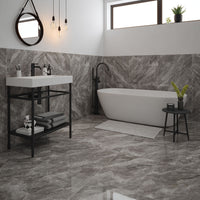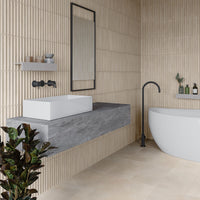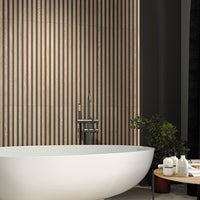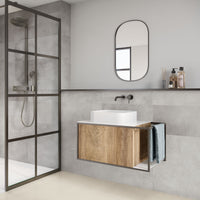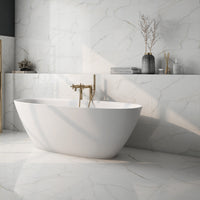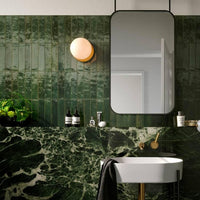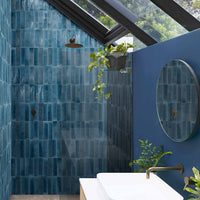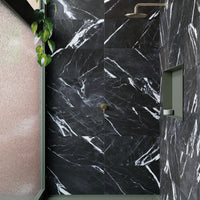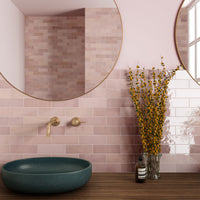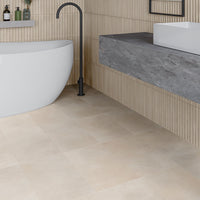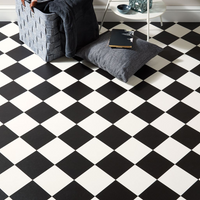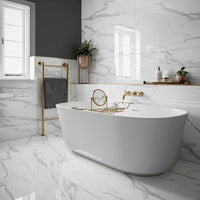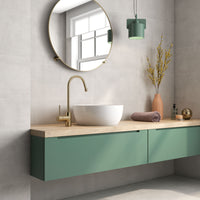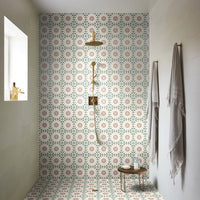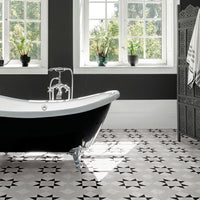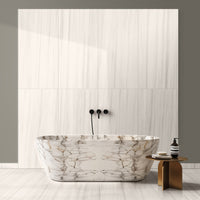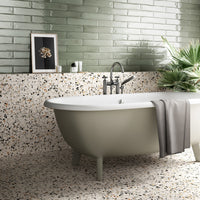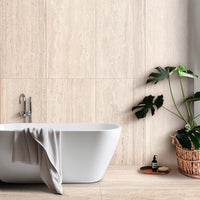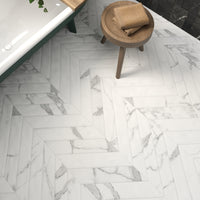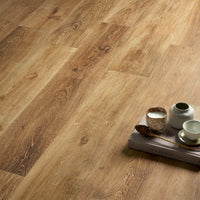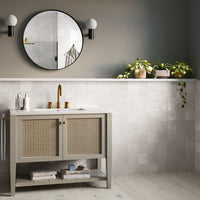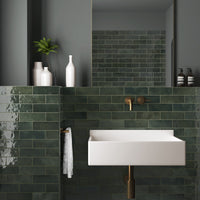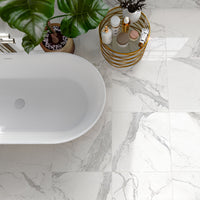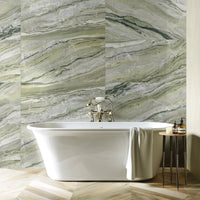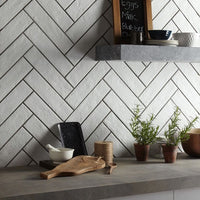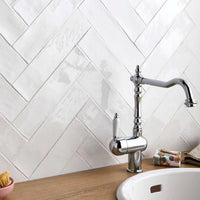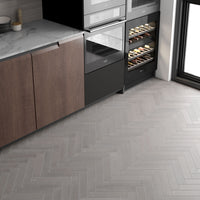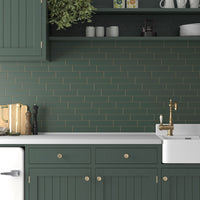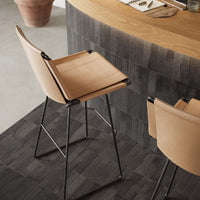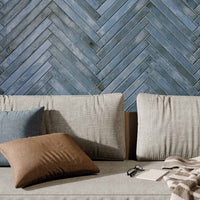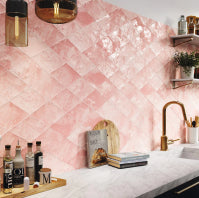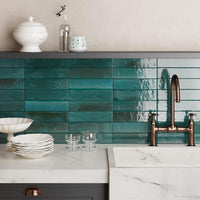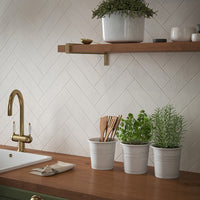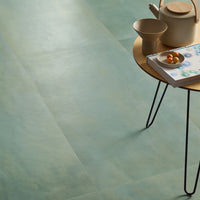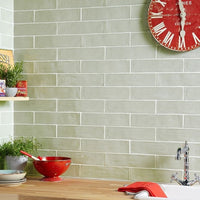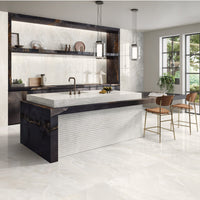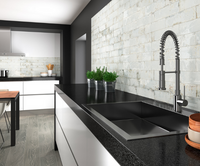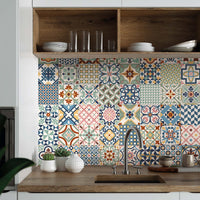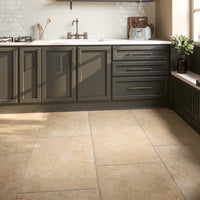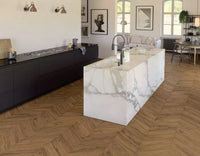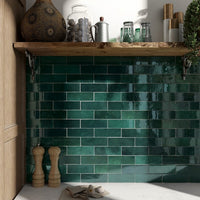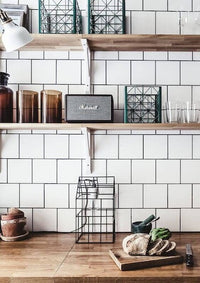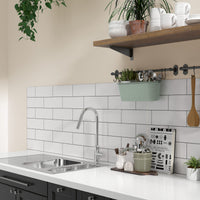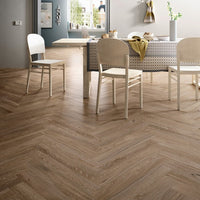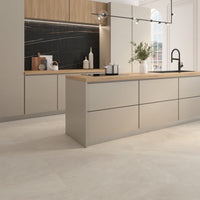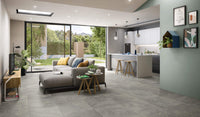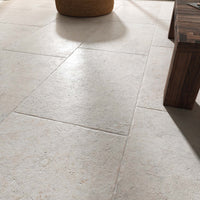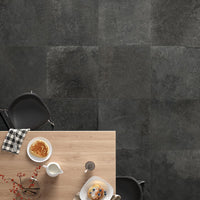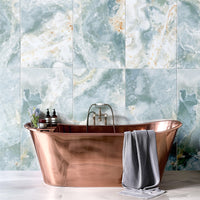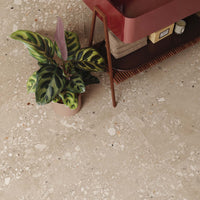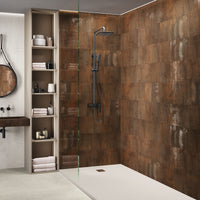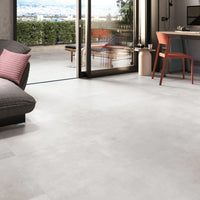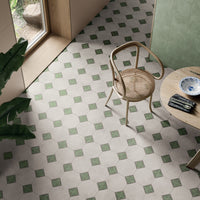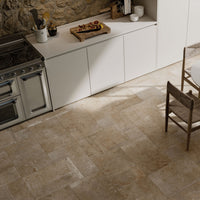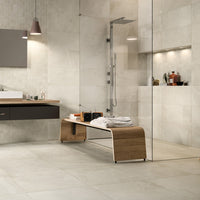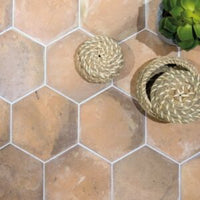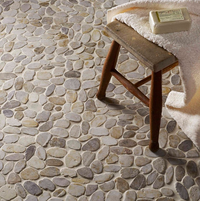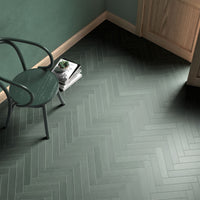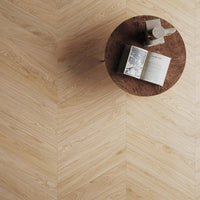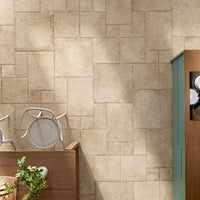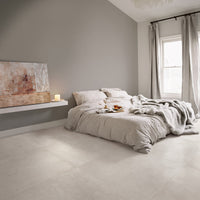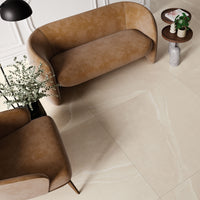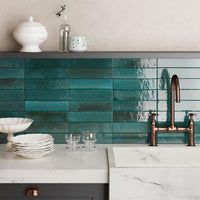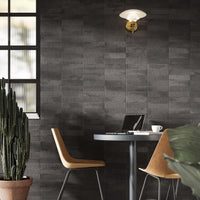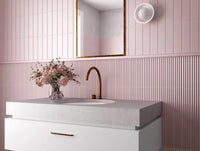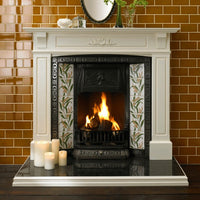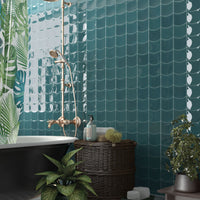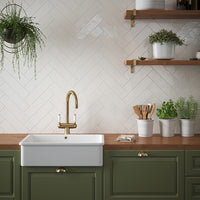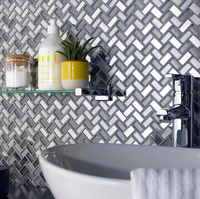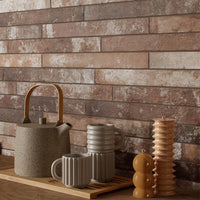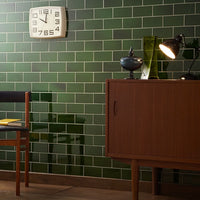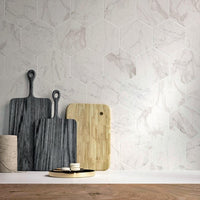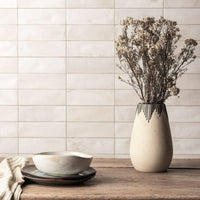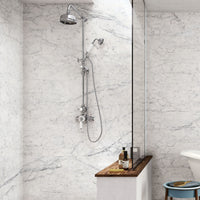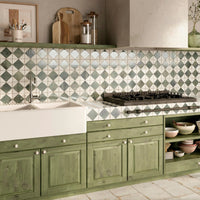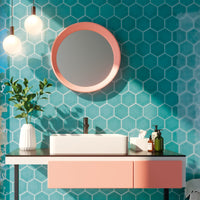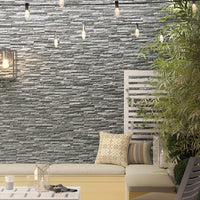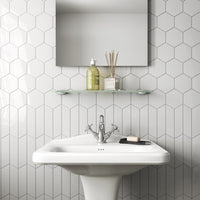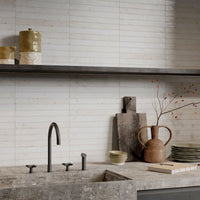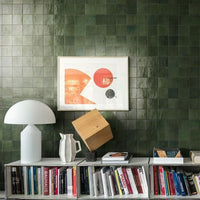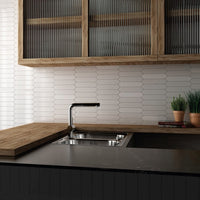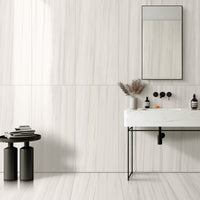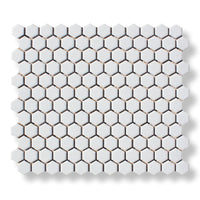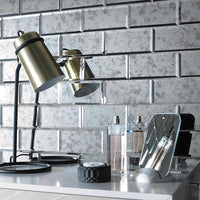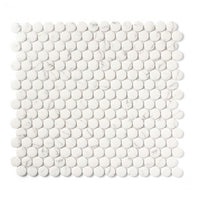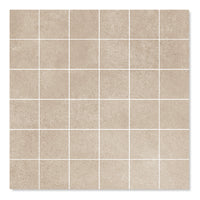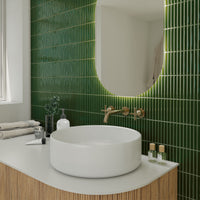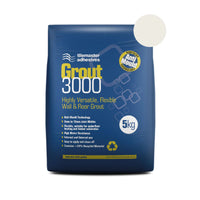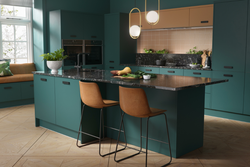If you’re looking at new flooring for your home, there’s plenty of options available, from affordable vinyl sheets through to beautiful natural stones.
But over the last few years, floor tiles have become the number one choice for savvy homeowners. And there’s a simple reason why. Functional and beautiful, they offer maximum style underfoot - without breaking the bank.
With hundreds of different floor tile options available, choosing the right style and colour for your home can be a little, well, tricky. It’s crucial you get your flooring right - not only will it set the precedent for the rest of your room, it will, hopefully, be down for a very long time!
However, thanks to our years of expertise we’re here to help. This buying guide will cover everything you need to know, to help you find your perfect match.
What are floor tiles?
Unlike other coverings such as carpets or vinyl, floor tiles are hard and durable enough for any room at home. They’re usually manufactured using cutting edge ‘digital printing’ techniques, giving you all the beauty of exotic or natural materials, without the drawbacks.
At Porcelain Superstore, the majority of floor tiles we offer are made from porcelain. This is a harder and denser form of traditional ceramic tiles, so they’re absolutely ideal for busy, hard-working floors at home.
Click here to read a little more on the differences between porcelain and ceramic tiles.
What are the benefits of using floor tiles?
As a whole, tiles are having a moment. And with more styles available than ever before, there really is something for everyone.
However, there’s so much more to floor tiles than just beautiful designs. They offer numerous advantages over both natural choices such as wooden floors, and man-made materials such as laminate or carpet.
- Long lasting
By their nature, floor tiles are incredibly strong. Highly resistant to wear and tear, they’re well suited to high traffic floors and don’t scratch easily, unlike softer oak planks. - Low maintenance
Unlike carpet, which attracts dust and dirt, floor tiles are really easy to care for. A weekly brush is usually sufficient, while you can use a mop and general floor cleaner for a deeper clean. - Realistic designs
Thanks to cutting-edge technology, the latest tiles are indistinguishable from precious natural materials. So can enjoy the same beautiful style in any room, with the sky-high price tag. - Safe for families
Tiles are ideal if you suffer from asthma or allergies, as there’s nowhere for dust or pollen to hide. Furthermore, they don’t contain harmful VOCs, improving the air quality in your home. - Cost effective
Not only are tiles incredibly stylish and safe, they’re also extremely well-priced compared to alternatives. Best of all, they’ll last a very long time - saving you more money in the long-run. - Difficult to stain
Spills happen - and most other flooring options can stain quite easily. On the other hand, porcelain tiles are very difficult to stain and will maintain their looks with the minimum of fuss.
What are the best tiles for my floor?
Sometimes, when you’re designing a new room, you might know exactly what type of tile you’re after. For example, if you’re refreshing a Victorian terrace, you may already have a monochrome patterned tile in mind for the hallway.
But sometimes, of course, you might not. If so, it’s best to ask yourself a couple of questions, to help narrow your focus down:
- What room will you be using the tiles in? For example, a wet room will require a tile with a high slip-rating while highly polished tiles work well in luxury living rooms.
- What look are you aiming to achieve in the room? For example, if you’re creating a rustic shaker kitchen ten flagstone tiles will work better than concrete or terrazzo designs.
- How much would you like to spend? Although floor tiles are more affordable than alternatives, there are varying price points. Remember to account for adhesive, grout and installation!
- What laying pattern will work in your home? Laying tiles in different ways can alter the feel of your room - for example, a herringbone pattern tends to be more eye-catching than a regular grid layout.
Where can I use floor tiles?
Because of their hygienic natural, tiles are a natural fit for bathroom and kitchen flooring. However, porcelain floor tiles are incredibly versatile and these days, they’re used on almost any floor throughout the home.
So aside from the classic areas for floors tiles we’ve listed below, we also see customers using our tiles in their bedrooms, garages and even garden rooms!
- Bathrooms
Ceramic and porcelain tiles won’t rot or warp when they’re wet, so they’re a great choice for steamy bathrooms. - Kitchens
Unlike natural materials, floor tiles are difficult to stain so will look great year round, with the minimum of fuss. - Hallways
Floor tiles are well-suited to busy floors - they’re hard-working, durable and will withstand muddy boots and wet paws. - Living Rooms
Combine floor tiles with underfloor heating, for flooring that doesn’t just look good, it warms your home as well. - Utility Rooms
Practical spaces demand practical floors, so choose a porcelain tile that’s tough, won’t stain, and is easy to keep clean. - Conservatories
Great for conservatories, tiles aren’t just practical. Their colour won’t fade in the sun and they won’t warp with heat changes.
What styles of floor tile are available?
In the distant past, tiles were seen as a practical choice and design options were limited.
Thankfully, those days are long gone and today, there’s a wealth of floor tiles available, in almost every conceivable style or trend. Let’s take a look at some of the more popular options.
- Wooden wonders
Incredibly popular for hallways and living areas, wood look tiles give you the beauty of natural oak, with the practical aspect of porcelain. - Concrete
For a fresh take on industrial style, opt for large concrete-style tiles. Run from room to room, for seamless floors that are effortlessly chic. - Eternal Stone
Stone effect tiles offer a timeless charm and will work in any interior. Super realistic, they have a warm, elegant style that’s easy to live with. - Patterned Fun
Vibrant and joyful, patterned tiles are a hot interior trend. They will turn your floor into a creative canvas that will wow your friends and family. - Victorian Elegance
Classy and sophisticated, victorian floor tiles offer an unrivalled look and naturally work well in period homes - especially hallways and bathrooms. - Slate Beauty
Eternally popular, slate effect tiles work are ideal for both kitchens and bathrooms, giving you both durability and riven, rugged beauty. - Glorious Marble
Marble tiles perfectly blue the line between classic and contemporary. They’ll give your home a luxury edge that other materials simply can’t match. - Trendy Terrazzo
Incredibly satisfying to look at, terrazzo tiles are fun, stylish and always catch the eye. Perfect for trend-setting bathroom and kitchen floors, then! - Metallic Magic
Nothing says modern like metal and our metallic tiles give you shimmering style underfoot. With hints of glam, they’re ideal for floors both large and small. - Rustic Charm
With their warm tones, rustic style tiles fill any floor with wonderful character and beauty. Great for country kitchens and cosy family homes alike.
What colours are popular for floor tiles?
It goes without saying that different colours will have a different effect on your room, your home and ultimately, how you feel. So naturally, one of the biggest decisions you’ll have to make is which colouring to go for.
There’s no one-size fit’s all way to choose the right tone - our advice is to choose a colour based on the overall atmosphere you’re looking to create, rather than what’s currently hot.
- Modern Greys
When it comes to contemporary design, grey floor tiles are a failsafe choice. Light and pale or steely and dark, they will give you the perfect base for a modern yet timeless interior. - Warm Neutrals
Whether barely-there beige or richly coloured cream, warm neutral shades are calm yet contemporary. They work well in scandi-themed homes, especially when paired with darker accent walls. - Versatile Whites
Simple and uncomplicated, white is incredibly versatile. That’s why you’ll find white floors tiles used anywhere - they’re perfect both in minimal kitchens or soothing restful bathrooms. - Timeless Terracottas
With their warm hues, our terracotta imitations lose nothing of the traditional fired earth tiles we know and love. They’ll add character to any room - small spaces in particular. - Dark and Dramatic
When it comes to flooring, we often play it safe. So why not choose darker tones, if you want to create a room that’s a little different? Try your hallway - it’s an unexpected place for drama! - Monochrome magic
Black and white tiles always go together - but they don’t always have to be plain. Choose a geometric pattern to take a space from nice and tasteful to cool and contemporary.
What shape and size floor tile is right for me?
In the not-so-distant past, there was an element of ‘bigger is better’ when it comes to floor tiles. While there’s still an element of truth in that, it’s fair to say that tiles - and times - have changed. So these days, almost anything goes!
Whatever the shape and size of your room, it’s all about designing a space that reflects your personality and works for your family. Let’s take a closer look at some of the more popular choices.
- Hexagon
It’s easy to see why hexagon tiles have seen a revival - their honeycomb pattern adds instant impact and a completely different style to the straight lines you usually see with floor tiling. - Large format
Designed with open plan living rooms in mind, large format tiles are all about contemporary style. Think clean lines, fewer grout joints and floors that look almost seamless. - Flagstone
It’s difficult to look beyond flagstone tiling if you want your floor to provide warmth and character. Our durable porcelain imitations are ideal for kitchens and high traffic areas. - Plank
From bijou bathrooms to open plan ground floors, plank tiles work in just about any room. You’re guaranteed ever-lasting style, especially if you lay with a staggered joint. - Mosaic
While mosaics are often used for bath and wet room floors, they’ll add an unexpected twist to other rooms at home. Use a contrasting grout to make the joints stand out. - Parquet
With their intricate inlaid blocks, parquet style tiles are a wonderful way to add a luxurious flair to your floors. Perfect for a welcoming statement in a hallway, lounge or kitchen.
Popular floor tile laying patterns
Whether you’re re-designing your hallway or adding a large kitchen extension, it’s best to view the floor as a blank canvas. Alongside the style, colour, shape and size of your new tiles, you’ll also need to consider how they’re laid. So bring more to your floor, with these amazing laying patterns!
- Herringbone
Herringbone is always at the top of any wishlist and for good reason - it’s a classic choice that’ll add interest to any interior. - Offset
It's another classic floor tile design that's easy to lay, but it creates a little more visual variation. Great for flagstones in particular. - Grid
There’s a reason so many floors are laid in a grid-like pattern - it’s simple, practical and will help to make a room feel more spacious. - Diagonal
Add a little twist to the grid pattern, by laying square floor tiles at 45 degrees. Combine two block colour tiles to create your own effect.
How to get the indoor outdoor look
Our gardens are increasingly becoming extensions of our homes - a trend that’s been amplified since the start of the Covid pandemic. So we’re often asked if you can continue your flooring outside, for a modern and seamless transition.
The answer is, it depends. Indoor porcelain tiles are frost proof and will stand up to our often cold and drizzly climate. However, they need to be fixed onto a solid concrete base and you’ll also need to consider the tile’s slip rating.
At the risk of stating the obvious, a tile with a low slip rating can be very slippery when it’s wet - and most indoor tiles don’t score particularly high. While anti-slip surface treatments are available, our preferred advice is to use 20mm outdoor porcelain tiles.
As these are solely designed for outdoor use, they feature R11 slip ratings or above, so they’re ideal for wet weather. Furthermore, they can be laid onto a variety of substrates, including traditional sand and cement mortars.
Some of our tile ranges comprise 10mm indoor tiles and 20mm outdoor tiles, allowing you to continue your style outside, without any compromise on safety.
What floor tile finishes are available?
Floor tiles are available in numerous finishes, each of which will impact the look of your home in different ways.
- Polished
Floor tiles with a highly polished finish lend themselves to luxurious and elegant interiors. The reflective surface is achieved by running diamond polished wheels over the tiles, giving a more spectacular mirror-like sheen than traditional glossy tiles. - Matt
At the opposite end of the reflective scale, matt tiles have a contemporary surface with very little sheen, compared to polished tiles. They can vary in texture from completely flat to lightly textured and usually offer more slip resistance underfoot, so are ideal for many rooms. - Lappato
Sitting somewhere between matt and polished tiles, lappato tiles have a lightly polished surface. This gives them a honed finish that’s soft to touch, but still reflects some light around the room. They’re ideal for creating elegant floors that still catch the eye. - Riven
Popular in rustic interiors, riven tiles mimic the uneven texture you find in quarried stone and slate. By their nature, they tend to offer higher slip resistance underfloor, so are ideal for bathrooms and other wet areas. Great for traditional properties.
How much do floor tiles cost?
Floor tiles can vary in price, from the inexpensive to the, well, higher end of the scale. This means anything from under £20 per square metre for a simple ceramic floor tile, to around £100 per square metre for the latest Italian polished slabs.
At Porcelain Superstore, we focus on providing value to our customers, so you can expect to pay less for better quality tiles. While you can always find cheaper tiles elsewhere, they tend to be inferior products with fewer tile faces and less realistic designs.
There’s a lot to be said for the old saying that "quality is remembered, long after the price is forgotten"!
Can I use floor tiles outside?
Porcelain floor tiles are frost proof, so in theory they can be laid outside, onto a concrete slab. However, you will need to be mindful of slip ratings - many indoor floor tiles can be slippery outside when it’s wet.
For this reason, we would always recommend using our dedicated 20mm floor tiles outside, as they feature certified R11 slip ratings.
How do I lay floor tiles?
Floor tiles should always be laid onto a strong and solid base, such as cured concrete or tile backing boards. We don’t recommend tiling directly onto timber floorboards, as any movement can cause the tiles to crack or come loose over time.
Tiles should be fixed using a full bed of a cement-based, flexible tile adhesive such as Tilemaster Standard Set Setaflex. The joints between tiles should be filled in using a suitable grout, such as our Grout 3000 range.
You should never use a ready-mixed adhesive to fix floor tiles in place.
How hard-wearing are floor tiles?
One of the reasons porcelain floor tiles are so popular is because they’re so hard-wearing. Unlike softer materials such as timber, they won’t dent due to high heels and are compared to natural stone, they’re difficult to scratch.
However, not all porcelain tiles are equal and some are more hard wearing than others. This means, for example, that some tiles are well-suited to high traffic areas while others are designed for bathrooms floors. You can use the PEI rating to determine if a floor tile is suitable for your project or not.
Can I have tiles and underfloor heating?
Unlike many other floor coverings, all our ceramic and porcelain floor tiles can be safely laid over both electric and water underfloor heating systems. Thanks to their high thermal mass, tiles are very good at both conducting heat - so helping your room heat up quickly - and retaining heat, thereby helping your system work at its efficient best.
What colour grout should I use with my floor tiles?
There isn’t a right or wrong answer to this question, as grout colours are highly subjective. However, your choice of grout colour can be influenced by your overall interior style.
For example, in a contemporary living room with concrete effect tiles, you might wish to choose a closely matching grout colour, to emulate the seamless look of a polished concrete floor.
Alternatively, you may wish to use a contrasting grout when laying hexagon tiles, to highlight the honeycomb pattern.
A word of advice - use white grout on the floor with caution as it can stain very easily. Always treat your grout joints to help protect them against spills and staining over time.
What size grout joint should I use?
Tiles should always be laid with a grout joint, for two reasons:
- Firstly, the joint will absorb any movement from the tiles, reducing the risk of problems further down the line.
- Secondly, individual tiles are very rarely the exact same size - so the gap between the tiles will accommodate any sizing differences.
If you are using rectified floor tiles, where the edges are mechanically ground to a very precise tolerance, then you can usually use smaller 2mm tile spacers between your tiles.
If your tiles are unrectified, then we advise using larger tile spacers, to create a wider grout joint.
Certain tiles, such as modular patterns or tiles with wavy edges, may require larger joints of up to 5mm.
How to care for your new floor tiles
Compared to other flooring options, floor tiles are very easy to live with. So much so, they’re often referred to as low maintenance.
While this doesn’t mean no maintenance, it does mean that they should look their best, for a very long time, with just a relatively small amount of regular upkeep. As with all materials, you should wipe away any spills as quickly as possible, just to be on the safe side.
- For general daily cleaning, a soft brush or vacuum will clear up most dirt and debris.
- For weekly cleans, you can mop your tiles with regular floor cleaner, diluted in warm water.
- More stubborn stains may require the use of a specialised tile cleaner, such as our LTP Floor Tile Cleaner.
A word of advice - the initial ‘tiler’s clean’ immediately after grouting is vital. This will help to stop grout haze from forming on the surface of your new tiles, which can cause the tiles to attract dirt and look discoloured.
Grout haze can only be removed by using a suitable remover, such as LTP grout Stain Remover.
How do I avoid lippage between tiles?
Porcelain tiles can bend over their length, ever so slightly. This ‘bowing’ is often more noticeable on larger tiles, although in practically all cases it isn’t a defect.
Unfortunately, with certain laying patterns this bowing can sometimes lead to lippage between tiles, where the edges aren’t completely flat. Fortunately, this issue is very easy to avoid if a tile levelling system is used during installed.
These help to ensure a flat, level floor, across adjoining tiles. Please don’t lay plank or large format tiles with a normal brick bond pattern. Instead, stagger the joints by a maximum of one-third the length of the tile. If the surface you’re tiling onto isn’t completely level, we recommend the use of levelling compound.
Free and speedy floor tile samples
And finally, as we’ve mentioned floor tiles are designed to be laid for a very long time. Therefore, it’s crucial you make the right decision. After all, no-one wants to go through the expense of hassle of taking up and re-tiling a newly laid floor!
At Porcelain Superstore, we offer a free and speedy sample service, so you can try your favourite floor tile designs at home, helping you make the right choice.
